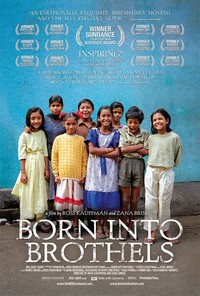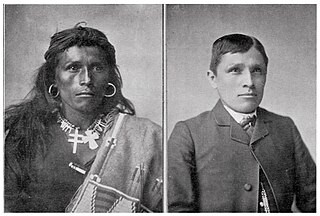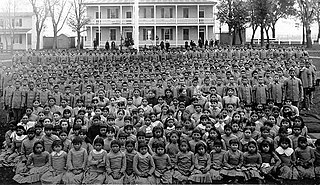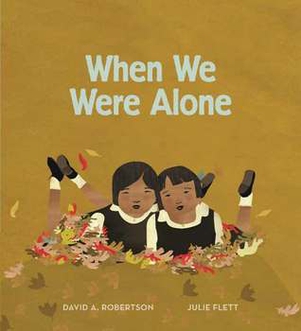
The Canadian Indian residential school system was a network of boarding schools for Indigenous peoples. The network was funded by the Canadian government's Department of Indian Affairs and administered by Christian churches. The school system was created to isolate Indigenous children from the influence of their own culture and religion in order to assimilate them into the dominant Canadian culture. Over the course of the system's more than hundred-year existence, around 150,000 children were placed in residential schools nationally. By the 1930s, about 30 percent of Indigenous children were attending residential schools. The number of school-related deaths remains unknown due to incomplete records. Estimates range from 3,200 to over 30,000, mostly from disease.

Alanis Obomsawin, is an Abenaki American-Canadian filmmaker, singer, artist, and activist primarily known for her documentary films. Born in New Hampshire, United States and raised primarily in Quebec, Canada, she has written and directed many National Film Board of Canada documentaries on First Nations issues. Obomsawin is a member of Film Fatales independent women filmmakers.

Born into Brothels: Calcutta's Red Light Kids is a 2004 Indian-American documentary film about the children of prostitutes in Sonagachi, Kolkata's red light district. The widely acclaimed film, written and directed by Zana Briski and Ross Kauffman, won a string of accolades including the Academy Award for Best Documentary Feature in 2005.

The United States Indian Industrial School in Carlisle, Pennsylvania, generally known as Carlisle Indian Industrial School, was the flagship Indian boarding school in the United States from its founding in 1879 through 1918. It was based in the historic Carlisle Barracks, which was transferred to the Department of Interior from the War Department for the purpose of establishing the school. After the United States entered World War I, however, the school was closed, and the property on which it was located was transferred back for use by the U.S. Department of Defense. The property is now part of the U.S. Army War College.

Brigadier General Richard Henry Pratt was an American military officer who founded and was longtime superintendent of the influential Carlisle Indian Industrial School at Carlisle, Pennsylvania.

Where the Spirit Lives is a 1989 television film about Aboriginal children in Canada being taken from their tribes to attend residential schools for assimilation into majority culture. Written by Keith Ross Leckie and directed by Bruce Pittman, it aired on CBC Television on October 29, 1989. It was also shown in the United States on PBS on June 6, 1990, as part of the American Playhouse series and was screened at multiple film festivals in Canada and the United States.

Stereotypes of Indigenous peoples of Canada and the United States of America include many ethnic stereotypes found worldwide which include historical misrepresentations and the oversimplification of hundreds of Indigenous cultures. Negative stereotypes are associated with prejudice and discrimination that continue to affect the lives of Indigenous peoples.

A series of efforts were made by the United States to assimilate Native Americans into mainstream European–American culture between the years of 1790 and 1920. George Washington and Henry Knox were first to propose, in the American context, the cultural assimilation of Native Americans. They formulated a policy to encourage the so-called "civilizing process". With increased waves of immigration from Europe, there was growing public support for education to encourage a standard set of cultural values and practices to be held in common by the majority of citizens. Education was viewed as the primary method in the acculturation process for minorities.

The Kamloops Indian Residential School was part of the Canadian Indian residential school system. Located in Kamloops, British Columbia, it was once the largest residential school in Canada, with its enrolment peaking at 500 in the 1950s. The school was established in 1890 and operated until 1969, when it was taken over from the Catholic Church by the federal government to be used as a day school residence. It closed in 1978. The school building still stands today, and is located on the Tk’emlúps te Secwépemc First Nation.

The Truth and Reconciliation Commission of Canada was a truth and reconciliation commission active in Canada from 2008 to 2015, organized by the parties of the Indian Residential Schools Settlement Agreement.

American Indian boarding schools, also known more recently as American Indian residential schools, were established in the United States from the mid-17th to the early 20th centuries with a primary objective of "civilizing" or assimilating Native American children and youth into Anglo-American culture. In the process, these schools denigrated Native American culture and made children give up their languages and religion. At the same time the schools provided a basic Western education. These boarding schools were first established by Christian missionaries of various denominations. The missionaries were often approved by the federal government to start both missions and schools on reservations, especially in the lightly populated areas of the West. In the late 19th and early 20th centuries especially, the government paid religious orders to provide basic education to Native American children on reservations, and later established its own schools on reservations. The Bureau of Indian Affairs (BIA) also founded additional off-reservation boarding schools based on the assimilation model. These sometimes drew children from a variety of tribes. In addition, religious orders established off-reservation schools.

Thomas Indian School, also known as the Thomas Asylum of Orphan and Destitute Indian Children, is a historic school and national historic district located near Irving at the Cattaraugus Indian Reservation in Erie County, New York. The institution was first established in 1855 by missionaries Asher Wright and his wife Laura Wright to house the orphaned and kidnapped Seneca children of the reservation under the federal policy of forced assimilation. The complex was built in about 1900 by New York State as a self-supporting campus. Designed by the New York City firm Barney and Chapman, the campus contains the red brick Georgian Revival style main buildings and a multitude of farm and vocational buildings.

Two-spirit is a contemporary pan-Indian umbrella term used by some Indigenous North Americans to describe Native people who fulfill a traditional third-gender social role in their communities.

Older than America is 2008 American suspense drama film directed by Georgina Lightning and starring Adam Beach, Wes Studi, Tantoo Cardinal, Georgina Lightning and Bradley Cooper. The film explores the devastating personal and cultural effects of the American Indian boarding schools on the members of a Native American family in Minnesota.
We Were Children is a 2012 Canadian documentary film about the experiences of First Nations children in the Canadian Indian residential school system.

Bringing the Circle Together was an influential free film series in downtown Los Angeles, by and about Native Americans. The series was held monthly from 2008 to 2012 and was a central gathering place for Indigenous peoples and their supporters to discuss issues, and share historical narratives, art, and traditions.

Dodging Bullets—Stories from Survivors of Historical Trauma is a documentary film on historical trauma in Indian country, co-directed by Kathy Broere (Blackfeet), Sarah Edstrom, Jonathan Thunder, and Bob Trench, and produced by Larry Long with soundtrack by Keith Secola. The film focuses on historical events and how they inter-generationally affect the Indigenous population in North America today. It premiered at the Minneapolis–Saint Paul International Film Festival where it was awarded "Best of Fest" and was awarded The Samuel Sprynczynatyk Storyteller Award: Best Documentary Feature at the North Dakota Human Rights Film Festival. Filmed across the lands of the Plains Indians, which is now known as Wisconsin, Minnesota, the Dakotas, Nebraska, Colorado, and Montana, the film recalls first-hand storytelling that reflects how past generations were deeply impacted by mass trauma and how that trauma influences Indigenous peoples of the Americas today. The film ends on a positive path to healing through ceremony and cultural identity.
The Federal Indian Boarding School Initiative was created in June 2021 by Deb Haaland, the United States Secretary of the Interior, to investigate defunct residential boarding schools established under the Civilization Fund Act and that housed Native American children. It is an effort to document known schools and burial grounds, including those with unmarked graves. There will be an attempt to identify and repatriate children's remains to their families or nations.

When We Were Alone is a children's book written by David Robertson, illustrated by Julie Flett and published December 1, 2016 by HighWater Press. The book is published in English, and one edition include text in Swampy Cree syllabics and Roman orthography, translated by Alderick Leask.

Mary Augusta Tappage Evans (1888–1978) was a Shuswap-Métis elder, midwife, and storyteller. As a child, she was separated from her family and sent to the Indian boarding school at Saint Joseph's Mission. A member of the Soda Creek/Deep Creek Band, she married at the age of 15 and had four children. She was a self-taught midwife. Stories from her life were recorded and published in 1971 in the book The Days of Augusta.

















